A medical condition Orthostatic hypotension is a complicated and clinically significant cardiovascular syndrome, that primarily affects elderly persons and people with other medical disorders.
An extreme drop in blood pressure after standing is a symptom of Orthostatic hypotension (OH), a chronic illness caused by compromised compensatory systems such as baroreflex failure. Baroreflex failure is an uncommon condition that results in irregular heart rate and blood pressure fluctuations. Elderly and neurologically disabled people, especially those with Parkinson’s disease or diabetic neuropathy, are frequently affected by its weakening effects.
Furthermore, postural hypotension is another name for this medical condition, which is a decrease in blood pressure that occurs when one stands up after sitting or lying down. It is described as a reduction in:
Diastolic blood pressure: Within three minutes of standing blood pressure drops by at least 10 mm Hg
Systolic blood pressure: by at least 20 mm Hg.
Orthostatic hypotension is a sign of more extensive cardiovascular and autonomic system malfunction. Even while treatment can reduce symptoms and enhance quality of life, more research is necessary to determine how it affects the long-term scenario. To address underlying causes and customize interventions to meet the needs of each patient, clinicians must take a patient-specific approach to Orthostatic hypotension.
Nonetheless, the force that flowing blood applies to the artery walls as it passes through the body is measured by blood pressure. Two values, represented in millimeters of mercury (mmHg), are recorded for this vital cardiovascular health indicator:
- Systolic Blood Pressure
The highest blood pressure reading figure symbolizes the pressure within the arteries during the heart’s contraction and subsequent pumping of blood into the bloodstream.
- Diastolic Blood Pressure
The blood pressure reading’s bottom number allows the heart to refill with blood by indicating the pressure in the arteries during the intervals between beats.
Types of Blood Pressure
- Typical: Less than 120/80 mmHg.
- Hypotension, or low blood pressure, is less than 90/60 mmHg.
Taking a Blood Pressure Reading
Systolic/diastolic blood pressure is expressed as, for example, 120/80 mmHg. These numbers are used by medical professionals to evaluate cardiovascular health and identify diseases such as hypertension or hypotension.
To avoid consequences like heart disease, stroke, and organ damage, it is crucial to maintain a healthy blood pressure level.
Is orthostatic hypotension dangerous?
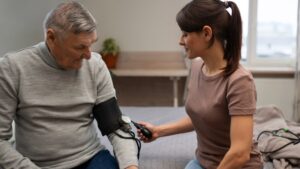
Some Health dangers may arise from orthostatic hypotension, particularly if treatment is not received or if episodes become frequent. The severity, underlying causes, and related consequences determine how dangerous it is.
Falls brought on by sudden lightheadedness or fainting (syncope) brought on by a drop in blood pressure can cause fractures or other severe injuries, particularly in the elderly.
Chronic symptoms like dizziness, exhaustion, and fainting can greatly impair movement and day-to-day activities.
Low blood pressure episodes that occur frequently can decrease blood flow to the brain, which may lead to confusion, memory issues, or in extreme situations, vascular dementia.
Higher Chance of Heart-Related Events
Orthostatic hypotension is associated with an increased risk of conditions such as:
- Heart failure
- Heart disease
- A stroke
- Hypertension in the spine
Nevertheless, orthostatic hypotension can be harmful, especially if it causes cardiovascular problems, falls, or cognitive impairment. To lower risks and enhance the quality of life, early diagnosis, and appropriate treatment are crucial. It’s critical to get medical help if symptoms are severe or frequent.
Who Is at Risk of Orthostatic hypotension?

Although orthostatic hypotension can happen to anyone, there are numerous variables that make it more likely to happen, especially as people age.
Medical Conditions
- Vitamin B12 deficiency or anemia can affect blood pressure control and oxygen delivery.
- Dehydration: Lowers blood volume and can be brought on by vomiting, diarrhea, or diuretics.
- Diabetes, thyroid conditions, and Addison’s disease are examples of endocrine disorders that can interfere with blood pressure regulation.
- Cardiac conditions that affect blood circulation include arrhythmias and cardiac valve dysfunction.
- Neurological disorders that impact the autonomic nervous system include dementia and Parkinson’s disease.
- Extended Immobility For instance, bed rest during pregnancy or illness can cause this.
Additional Elements
- Medication: Medications used to treat depression, heart disease, or high blood pressure may be a factor.
- Pregnancy: The body experiences major cardiovascular changes, particularly during the first 24 weeks.
Symptoms of Orthostatic hypotension

- Mild Cases: Temporary dizziness or faintness.
- Severe Cases: episodes of confusion brought on by decreased brain perfusion, falls, or syncope (fainting).
Generally;
- Blurry vision
- Lightheadedness
- Feeling dizzy
- Mental confusion
- Feeling nervous
- Tremors in the muscles
- Fainting
Types and Causes of Orthostatic hypotension
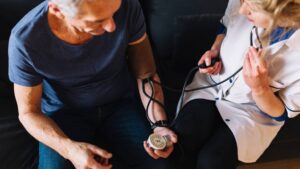
Occasional or Acute OH
Usually brought on by temporary factors like:
- Dehydration: The body’s capacity to control blood pressure is weakened by decreased blood volume.
- Extended Bed Rest: Baroreflex systems are weakened by decreased physical activity.
- Drugs: Antidepressants, diuretics, and antihypertensives can all drastically reduce blood pressure.
Chronic OH
Shows the presence of an underlying medical issue, like:
- Neurological conditions include multiple system atrophy, diabetic neuropathy, and Parkinson’s disease.
- Cardiovascular problems include arrhythmias and heart failure.
- Endocrine disorders include hypothyroidism and adrenal insufficiency.
Nonetheless, simply put, when the body fails to sufficiently compensate for the effects of gravity on blood circulation during the transition to an upright position, the outcome is orthostatic hypotension (OH).
There are two types of causes for it:
- Neurogenic
- Non-neurogenic

-
Causes of Neurogenesis
These result from a malfunction in the autonomic nervous system’s blood pressure regulation function.
Peripheral Neuropathies
Long-term diabetes frequently results in diabetic neuropathy, which damages nerves and disrupts baroreflex systems.
Autoimmune Neuropathies: Autonomic fibers may be impacted by diseases like Sjögren’s syndrome or Guillain-Barré syndrome.
Disorders of the Central Nervous System:
OH is frequently a sign of Parkinson’s disease (PD) and may appear before motor symptoms.
Multiple System Atrophy (MSA) is a Parkinsonian illness that has a worse prognosis than Parkinson’s disease (PD) with substantial autonomic dysfunction.
OH and other severe autonomic dysfunction are linked to Lewy body dementia.
Using Time as a Diagnostic Hint:
PD may be suggested by gradual progression of Orthostatic hypotension.
Severe early Orthostatic hypotension or rapid onset frequently indicates Lewy body dementia or MSA.
-
NonNeurogenic Causes
The body’s compensating systems are hampered by direct cardiovascular, volume, or drug-induced consequences.
Heart Impairment
Myocardial Infarction: Decreases cardiac output, making it more difficult to keep blood pressure stable while standing.
OH is made worse by aortic stenosis, which restricts blood flow from the heart.
Depletion of Volume
Dehydration: Caused by diarrhea, vomiting, or a lack of fluids.
Adrenal insufficiency: Reduced salt retention due to impaired aldosterone secretion results in a drop in blood volume.
Vasodilation
Reduced vascular tone and systemic vasodilation are caused by fever or sepsis.
Systemic Mastocytosis: Episodes of vasodilation are caused by the release of vasoactive mediators such as histamine.
Suggestions for Management and Diagnosis of Orthostatic hypotension
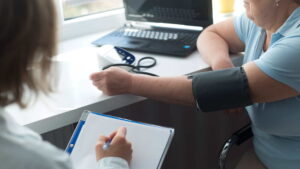
- Determining the best course of action requires an understanding of the reason.
- Addressing underlying autonomic dysfunction is crucial for neurogenic OH.
- Results for nonneurogenic OH can be greatly enhanced by controlling volume depletion, cardiac reasons, or changing medication.
- Drug-induced OH can be avoided with careful medication assessment, especially in older or fragile patients.
- Treatment can be customized to reduce symptoms and enhance quality of life by recognizing and addressing these factors.
Pathophysiology of Orthostatic hypotension
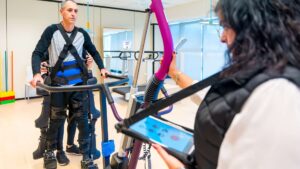
Here is a quick overview of the main OH-related points:
Autonomic Dysfunction: Because the autonomic nerve system controls blood pressure and vascular tone, OH is frequently associated with dysfunction in this system. Reduced brain perfusion and insufficient blood flow are the results of dysregulation in response to postural changes.
- Neurological conditions include multiple system atrophy and Parkinson’s disease.
- Non-neurological elements, such as the impact of medications, diabetes, or dehydration
Changes Associated with Age: Vascular stiffness and decreased baroreceptor sensitivity increase vulnerability in the elderly.
Prognostic Significance
Adverse Effects: Heart failure, stroke, and coronary artery disease are all made more likely by OH.
Cognitive impairment, most likely brought on by long-term brain hypoperfusion.
Greater death rates, as shown by some cohort studies
Quality of Life: Symptoms including exhaustion, lightheadedness, and fainting seriously hinder independence and day-to-day functioning.
Postural Blood Redistribution: Because of gravity, standing causes blood to pool in the lower limits, which lowers:
- The heart’s venous return
- Filling of the ventricles
- Arterial pressure and cardiac output
Paying Baroreflex: Normally, when blood pressure drops, arterial baroreceptors in the carotid sinus and aortic arch detect it and start:
Tachycardia reflex
Autonomic pathways and brainstem centers mediate vasoconstriction.
When any part of this system fails, neurogenic Orthostatic hypotension occurs, which is typified by insufficient blood pressure recovery.
Orthostatic hypotension in elders

Because of a combination of chronic comorbidities, pharmaceutical use, and physiological aging processes, Orthostatic hypotension (OH) is far more common in older people.
Age-Related alterations: OH is a result of decreased autonomic reactivity to postural alterations and decreased baroreceptor sensitivity.
Reduced central blood volume and pressure result from blood being shunted to the intestines for digestion, which is known as postprandial hypotension.
The most common time for OH to happen is 15 to 45 minutes after eating.
Extended Standing: Prolonged standing causes blood to gradually accumulate in the lower extremities, irritating OH.
Frailty and Chronic Illness: Frailty brought on by aging is linked to a decreased cardiovascular reserve, which reduces the effectiveness of blood pressure control.
Diabetes, Parkinson’s disease, cardiovascular diseases, and other chronic conditions are common causes.
Many drugs (such as sedatives, diuretics, and antihypertensives) contribute to OH, and polypharmacy is prevalent in older persons.
Autonomic and vascular responses may be further compromised by drug interactions.
Neurological Conditions: Neurogenic OH is more common in older persons with Parkinson’s disease, multiple system atrophy, and diabetic neuropathy.
Cardiovascular diseases: Inadequate compensating mechanisms are a result of heart failure, myocardial infarction, and valve diseases.
Management Implications of Symptoms of Orthostatic hypotension
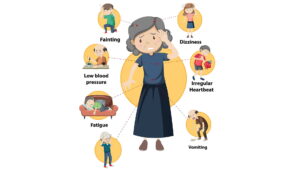
Regular Monitoring: In the care of the elderly, regular blood pressure checks, which include postural measurements, are essential.
Specific Interventions: Symptoms of Orthostatic hypotension can be lessened by addressing risk factors such as post-prandial hypotension by eating smaller, more frequent meals or by using supportive aids to manage prolonged standing.
Review of Medication: It is crucial to routinely assess the role that drugs play in OH, particularly in older patients who are frail or institutionalized.
A Holistic Approach to Care: Reducing falls brought on by OH and preserving circulatory health can be achieved by controlling comorbidities and promoting safe physical activity.
Customized approaches might lessen the effects of orthostatic hypotension and enhance the general quality of life by taking into account the particular vulnerabilities of older populations.
Diagnosis of Orthostatic hypotension

To detect Orthostatic hypotension, medical professionals use a physical examination, medical history, and diagnostic tests:
Monitoring of Blood Pressure
In order to track changes, blood pressure is taken while the patient is standing, sitting, and lying down.
Tests for diagnosis
- Blood tests: To look for underlying diseases such as diabetes or anemia.
- Echocardiogram: Assesses how well the heart pumps.
- An electrocardiogram (EKG) can identify irregular heartbeats.
- Exercise Stress Test: Measures blood pressure and heart rate while exerting oneself.
- A portable EKG gadget called a Holter Monitor is worn to continuously record cardiac rhythms.
- Tilt Table Test: Simulates positional changes by tilting the table from horizontal to vertical while tracking blood pressure, heart rate, and rhythm.
- These assessments aid in identifying the root problem and directing the proper course of action.
- Measurements of blood pressure during postural changes are part of the diagnosis process.
- Determining the causes (such as drugs, dehydration, or autonomic dysfunction)
- Thorough evaluation to rule out underlying issues
Handling and treatment of Orthostatic hypotension
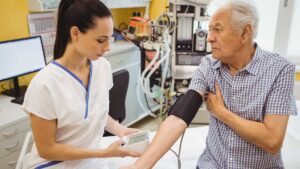
Non-pharmacological interventions include lifestyle modifications such as wearing compression clothing, gradually shifting positions, and consuming more salt and water.
Physical measures include tilting the head of the bed or calf strengthening exercises.
Interventions using Pharmacology:
Fludrocortisone is a volume expansion agent that raises plasma volume.
Midodrine is a vasoconstrictor that improves vascular tone.
Other medications that target particular autonomic control pathways include droxidopa and pyridostigmine.
Absence of Prognostic Evidence: Although these treatments reduce symptoms, there is not enough information from randomized trials to determine how they affect long-term outcomes like morbidity and mortality.
Clinical and Research Views
Data Requirement: The lack of extensive, randomized controlled trials restricts our ability to determine if treating OH can enhance prognosis or reduce related risks.
New Perspectives: To improve diagnostic standards, pinpoint groups at risk, and assess the impact of therapies on tangible outcomes like survival and cardiovascular events, more research is required.
Strategies for Orthostatic Hypotension Management
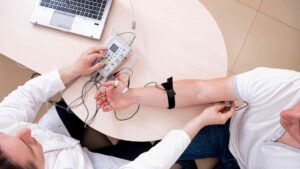
Because of its complexity, OH care varies from patient to patient, striking a balance between symptom alleviation and avoiding consequences such as supine hypertension. Instead of aiming for normal standing blood pressure, the treatment focuses on increasing standing tolerance and functionality.
Nonpharmacologic Techniques
These methods serve as the cornerstone of OH management:
Patient education: Describe OH’s characteristics, stressing its chronicity and the significance of changing one’s behavior.
Salt Intake and Hydration: Promote excessive fluid intake.
Increase the amount of salt in your diet, unless concomitant diseases such as chronic kidney disease or heart failure make it contraindicated.
Compression Garments: To increase venous return, wear graded compression stockings or abdominal binders.
Physical Rebuttal Techniques:
To improve blood flow, cross your legs and tense your muscles.
Avoid standing for extended periods and do things like get out of bed slowly.
Sleep Positioning: To reduce morning hypotension and supine hypertension, raise the head of the bed.
Dietary Changes: Avoid postprandial hypotension by eating small, frequent meals.
Drug-Based Interventions
Although they can be used in conjunction with non-pharmacological approaches, medications must be used carefully to avoid adverse effects like supine hypertension.
Agents that expand volume:
Fludrocortisone: Increases blood volume by improving sodium retention.
Vasopressors:
A short-acting α1-adrenergic agonist that increases vascular tone is midodrine.
Droxidopa: Lowers standing blood pressure by acting as a norepinephrine precursor for neurogenic OH.
Adrenergic Inducing Agents:
Pyridostigmine: Reduces hypotensive episodes without causing severe supine hypertension by increasing neurotransmitter availability.
Obstacles and Things to Think About
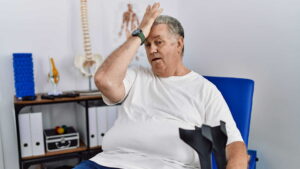
A typical side effect of treating OH is supine hypertension, which can be controlled with lifestyle changes including raising one’s head while sleeping or adjusting drug schedules.
Circumstantial Variability: The symptoms of OH change with the time of day, the foods consumed recently, and the amount of physical activity, hence a dynamic approach to care is required.
Absence of Curative Treatment: Since OH is frequently a sign of irreversible autonomic dysfunction, the focus is still on enhancing the quality of life by symptom mitigation.
Nonetheless, Orthostatic hypotension is a complicated condition that can have major consequences if ignored. It is characterized by a substantial decrease in blood pressure when standing and Orthostatic hypotension fainting which can be harmful. Chronic types of the illness can cause crippling symptoms, even though they are often moderate and episodic.
Orthostatic hypotension is not a life-threatening condition in and of itself, but if aggressively treated, it is linked to higher risks of cardiovascular events, cognitive loss, and complications such as supine hypertension. Therefore, it is essential to take an all-inclusive strategy and deal with the underlying reason.
Better symptom control, increased mobility, and an improved quality of life can be made possible by early diagnosis, patient education, and personalized care, which can greatly reduce the risks. Long-term results can be improved and complications can be avoided by acknowledging its presence, especially in the elderly and weak, and encouraging a proactive management approach.













